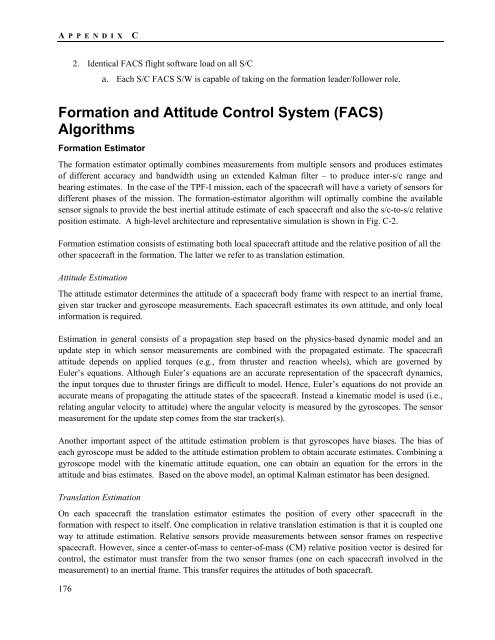TPF-I SWG Report - Exoplanet Exploration Program - NASA
TPF-I SWG Report - Exoplanet Exploration Program - NASA
TPF-I SWG Report - Exoplanet Exploration Program - NASA
Create successful ePaper yourself
Turn your PDF publications into a flip-book with our unique Google optimized e-Paper software.
A PPENDIX C<br />
2. Identical FACS flight software load on all S/C<br />
a. Each S/C FACS S/W is capable of taking on the formation leader/follower role.<br />
Formation and Attitude Control System (FACS)<br />
Algorithms<br />
Formation Estimator<br />
The formation estimator optimally combines measurements from multiple sensors and produces estimates<br />
of different accuracy and bandwidth using an extended Kalman filter – to produce inter-s/c range and<br />
bearing estimates. In the case of the <strong>TPF</strong>-I mission, each of the spacecraft will have a variety of sensors for<br />
different phases of the mission. The formation-estimator algorithm will optimally combine the available<br />
sensor signals to provide the best inertial attitude estimate of each spacecraft and also the s/c-to-s/c relative<br />
position estimate. A high-level architecture and representative simulation is shown in Fig. C-2.<br />
Formation estimation consists of estimating both local spacecraft attitude and the relative position of all the<br />
other spacecraft in the formation. The latter we refer to as translation estimation.<br />
Attitude Estimation<br />
The attitude estimator determines the attitude of a spacecraft body frame with respect to an inertial frame,<br />
given star tracker and gyroscope measurements. Each spacecraft estimates its own attitude, and only local<br />
information is required.<br />
Estimation in general consists of a propagation step based on the physics-based dynamic model and an<br />
update step in which sensor measurements are combined with the propagated estimate. The spacecraft<br />
attitude depends on applied torques (e.g., from thruster and reaction wheels), which are governed by<br />
Euler’s equations. Although Euler’s equations are an accurate representation of the spacecraft dynamics,<br />
the input torques due to thruster firings are difficult to model. Hence, Euler’s equations do not provide an<br />
accurate means of propagating the attitude states of the spacecraft. Instead a kinematic model is used (i.e.,<br />
relating angular velocity to attitude) where the angular velocity is measured by the gyroscopes. The sensor<br />
measurement for the update step comes from the star tracker(s).<br />
Another important aspect of the attitude estimation problem is that gyroscopes have biases. The bias of<br />
each gyroscope must be added to the attitude estimation problem to obtain accurate estimates. Combining a<br />
gyroscope model with the kinematic attitude equation, one can obtain an equation for the errors in the<br />
attitude and bias estimates. Based on the above model, an optimal Kalman estimator has been designed.<br />
Translation Estimation<br />
On each spacecraft the translation estimator estimates the position of every other spacecraft in the<br />
formation with respect to itself. One complication in relative translation estimation is that it is coupled one<br />
way to attitude estimation. Relative sensors provide measurements between sensor frames on respective<br />
spacecraft. However, since a center-of-mass to center-of-mass (CM) relative position vector is desired for<br />
control, the estimator must transfer from the two sensor frames (one on each spacecraft involved in the<br />
measurement) to an inertial frame. This transfer requires the attitudes of both spacecraft.<br />
176
















